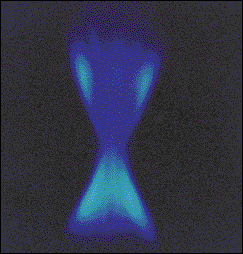For years, researchers have tried to explain the atomic processes behind sonoluminescence, the phenomenon in which ultrasonic waves break against a water bubble's surface and heat gas atoms inside. This rapid heating causes gas atoms to glow.

Physicist Sanjay Khare of Ohio State University at Columbus and Pritiraj Mohanty, a graduate student of physics at the University of Maryland at College Park may have taken the first step in uncovering this mystery.
Ultrasound-stimulated bubbles emit light in very short pulses, as short as a trillionth of a second. Khare and Mohanty theorized that it usually takes a longer time for an atom of gas to decay and emit light. However, when many atoms decay together, they do so at a faster rate. This would account for the short pulses of light observed in sonoluminescence.
If this theory proves correct, it could help explain sonoluminescence at the atomic level. Chemists believe they may be able to harness sonoluminescence to fuse atoms and form new materials.